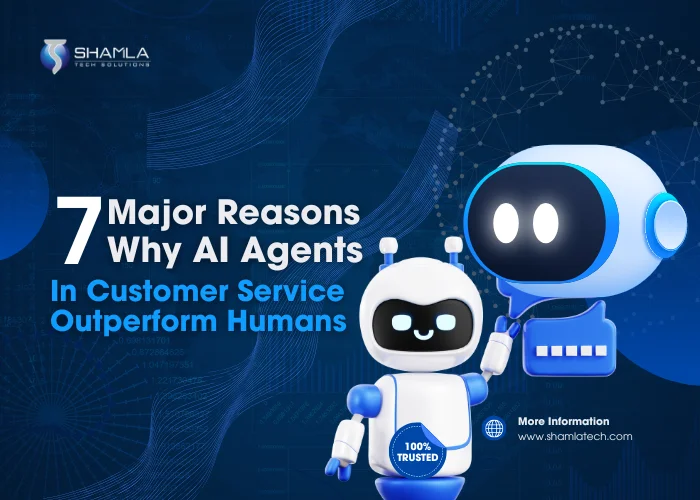AI is changing customer service fast. Companies use AI agents to handle tasks that humans find slow or hard. As customer demands grow, AI helps brands keep up. AI software can learn from large logs of data and give answers right away. It works all day and night without breaks and improves with each request. It routes issues, personalizes replies, and spots trends that human teams often miss. This blog will look at 7 proven benefits behind use cases of AI agents in support roles. By comparing speed, accuracy, and costs, we will show why smart software often beats human teams.
7 Reasons Why Customer Service AI Agents Outperform Humans
24/7 Availability and Instant Response Times
AI agents can run automatically without any breaks, giving support around the clock. They work in every time zone, so customers get answers when they need them. With no shift changes or lunch breaks, users avoid waiting. The steady service flow cuts hold times and keeps talks moving. This nonstop help lowers customer steps and stress. Businesses see fewer dropped chats and higher user trust, making operations smooth.
By using smart code and fast data lookups, response times drop to milliseconds. This precision cuts work for agents and removes customer hold. AI agent development has made it easy to link chatbots with email, phones, and apps. When an issue arrives, the system reads the request, matches patterns, and sends a clear answer.
Global firms face customer needs at night or on weekends. AI agents fill those gaps without extra staff or shift pay. Once set up, the system scales with demand, handling more chats when traffic spikes. This mix of alerts and answers keeps services smooth when overseas offices close, reliably at any time.
Removing wait cuts customer frustration and ends the ticket backlog fast. When an AI replies in milliseconds, users stay engaged and tasks complete sooner. The system logs each interaction to spot slow points and fix them. Over time, data shows drop in repeat contacts and higher feedback scores. Teams can then focus on hard cases and plan better. Quick answers drive loyalty and significantly cut support costs.
Consistency in Tone and Information
AI agents make use of many fixed templates and controlled language models which is done to provide uniform answers every time. They strip out mood shifts and distractions that affect human agents. Memory modules store brand guidelines and approved phrasing. This removes tone changes and errors from tired staff. With set content buses and validation rules, each reply sticks to core messages. Brands ensure customers hear the same promise, boosting clarity.
Engineering knowledge bases and rule engines secure brand voice across channels. Automated style checks scan each message against voice profiles, flagging deviations. Knowledge graphs map product-term links to maintain accuracy. Developers following guides on how to build an AI agent integrate these tools into pipelines. This setup removes edits, keeping messages precise and matching brand personality for every customer. It runs error checks to catch typos.
Centralized content stores log every AI reply creating audit trails for review. Consistent data outputs confirm agents stick to policy and legal needs. Feedback loops train models with examples, shutting down risky scripts. Version control archives message sets, letting teams roll back updates if errors slip through. Customers see stable answers that match brand claims each time. This reliability builds trust, raising satisfaction and sales.
Built-in test suites run on each code update, catching drift in language patterns. Regression checks compare new replies to benchmarks, ensuring consistency over time. Localization modules adapt tone and terms for regions without altering core messages. Admin dashboards track error rates and update flags for fixes. This cycle locks in stable performance. Customers experience familiar service every session, cementing brand confidence and boosting long-term loyalty.
Real-Time Data Access and Integration
AI systems tap into live customer databases and CRM platforms through secure APIs. They fetch order records, support tickets, and profile data in under a second. Query engines optimize data pulls by using indexes and caching layers. Once retrieved, the info feeds into dialogue flows that tailor responses. This real-time data access cuts lookups and manual searches, giving agents full context on each customer’s journey.
Integration frameworks connect AI agent development to back-end services like ERP and inventory systems. Using REST calls or WebSocket streams, systems merge purchase histories and stock levels to guide recommendations. Middleware layers normalize formats with JSON schemas and perform ETL in memory. These pipelines ensure data consistency and low latency. When a request arrives, the agent pulls user prefs and system states, generating accurate, personalized advice.
By running SQL queries on customer profiles, the system spots buying habits and service patterns. Data lakes store raw logs which ETL jobs convert into clean tables. Agents then merge that with real-time metrics like site activity and CRM data. This fusion powers context-aware dialog flows that adapt scripts on the fly, boosting reply relevance.
Orchestration engines call microservices to validate orders, check warranties, and update support tickets before response. AI pipelines use parallel threads and event-driven triggers to process data quickly. When a request enters, the engine syncs CRM, billing, and shipment records. The agent composes targeted solutions without manual lookups. This automation cuts resolution time and raises user satisfaction.
Lower Operational Costs
Automating support tasks cuts the need for many full time agents and lowers overhead costs. With a high concurrency system, each support instance runs on shared cloud instances. This spreads resource use and drops cost per contact. The shift from manual workflows to scalable pipelines slashes expenses. Budget freed supports growth initiatives without extra spend and maintenance.
An intelligent AI agent scales to high ticket loads without extra headcount. The elastic service uses container orchestration and autoscaling groups to match demand. Idle capacity shrinks during off peak hours, cutting compute spend. During traffic spikes, instances ramp up automatically. This design avoids hiring temp staff and training costs. The self managing environment handles thousands of requests per second with latency and error rates.
Upfront investment in AI platforms pays back quickly via cost per ticket reduction. Licensing fees and integration deliver long term value when spread across high volumes. With analytics dashboards, leaders track cost savings and agent efficiency. The platform’s modular design lets teams add or remove features based on ROI metrics. Over months, these gains compound, turning initial spend into measurable profit through lower operating expenses.
Maintenance costs drop as AI models update automatically via CI/CD pipelines. No server clusters idle or overspend; resource pools adjust in real time. Support teams shift from routine tasks to strategic projects, raising job value. Reduced human errors cut rework costs. With cost tracking APIs feeding finance systems, CFOs see clear ROI dashboards. The low total cost of ownership makes AI agent development a reliable choice.
Continuous Learning and Improvement
AI learns from feedback and past chats. It logs each interaction then uses data to update models with fine tuning. Continuous integration pipelines test new models daily. The system spots pattern shifts automatically. Models adapt without manual coding. Teams provide labeled samples to refine accuracy and reduce errors over time. Data scientists monitor drift alerts and adjust hyperparameters in minutes. AI pipelines improve continually.
AI training loops run on clusters, scanning user requests and new intents. The system flags shifts in query topics and adjusts dialogue trees. Retraining jobs pull the latest logs nightly and deploy improved weights. Agents learn new product lines within hours. Business rule engines load updated scripts. Rapid tuning reduces downtime and keeps AI aligned with customer needs.
AI models update through continual data feeds, cutting training cycles for staff. Training portals use microlearning modules that sync with model updates. This shift moves learning from workshops to bite-size tutorials. Agents review change logs instead of full retraining. Gamified dashboards track completion and competence. Managers converge on key skill gaps. Automated assessments confirm readiness. The human role adapts to oversight and strategy, not routine reruns.
Feedback loops use reinforcement learning to fine-tune dialogs after sessions. Reward functions measure success by resolution rates and user ratings. Data pipelines anonymize logs before model training to meet privacy rules. Batch jobs run weekly to retrain models. Canary deployments test updates on traffic slices. Real-time metrics dashboards compare live performance. This cycle ensures the AI agent development keeps improving without downtime or manual pushes continually.
Multilingual and Global Support
AI systems use built-in translation engines powered by neural networks to support dozens of languages at once. They load language packs and run inference pipelines in milliseconds. This setup requires parallel processing and GPU acceleration to keep speeds high. The system uses tokenizers that handle multi-script input and byte-pair encoding for new words. This instant language shift improves global coverage without extra staff or costs.
Language models integrate locale-specific modules and glossaries without manual input. AI routes queries through language detection services that pick the correct translation pipeline. This removes training cycles and cuts staffing needs. Developers deploy locale rules via configuration files and CI/CD workflows. The system auto-updates word lists from corpora and uses adaptive sampling to refine translations. This hands-off approach shrinks onboarding time and costs.
Regional adaptation modules adjust tone and word choice based on cultural rules stored in knowledge bases. Error handlers log events for quick fixes. The system monitors regional metrics and auto-tunes translation confidence thresholds. Customers receive seamless support in their native language everywhere daily.
By handling multiple languages at once, AI reduces reliance on human translators and cuts wait times. AI agents will transform the future of work by lowering training loads and speeding rollouts. Admin dashboards track error rates per language and route flagged messages for review. This unified approach scales global operations without extra offices or hiring cycles.
Better Compliance and Error Reduction
Automated compliance modules embed policy libraries directly in AI code. CI/CD pipelines run policy tests on each update, blocking violating scripts. Versioned models load only after passing compliance suites. Exception handlers catch edge violations and route them to human review. Test harnesses simulate high-risk dialogs to validate safeguards. Tokenization ensures sensitive data masks before logs. This setup minimizes mistakes and ensures strict rule adherence always.
Content filters and data validators block wrong facts and banned words before replies post. NLP classifiers label risky topics and route them to safe scripts. Encryption modules protect private fields. Legal wrappers check texts against policy libraries. Automated audits run daily to spot deviations. AI agent examples include banking bots that follow all the regulations and compliance set.
Every user chat logs into secure audit trails that record timestamps, inputs, and bot actions. Immutable records live in append-only stores. Analytics dashboards visualize error rates and compliance scores over time. Access controls restrict log views to authorized auditors. Data retention policies archive old records automatically. This detailed transparency supports routine quality checks and legal audits.
AI systems run on rule engines and script libraries that lock workflows. Policy modules enforce data handling, privacy, and security steps each time. Decision trees map conditions to allowed actions only. Validation layers check every output against compliance requirements. This strict setup removes guesswork and stops off-script replies. Teams update rules via version control to keep standards current. Audit logs capture each complete decision trace.
Conclusion
AI agent development surpass humans in response speed, data recall, and consistent logic. They complement human teams by handling routine tasks, freeing staff for empathy-driven interactions. Combining AI throughput with human judgment delivers seamless support. Businesses can thrive by integrating AI modules with human oversight to achieve high efficiency and real care.
Shamla Tech is an AI agent development company that builds custom support AI agents using NLP pipelines, secure APIs, and continuous learning frameworks. We have helped our clients to increase their resolution rates and cut the costs surrounding support which has drastically improved customer satisfaction.



